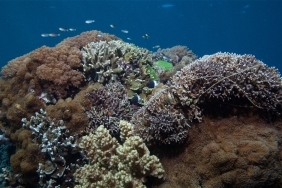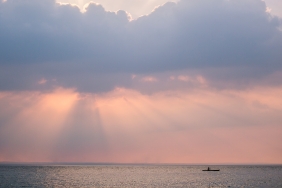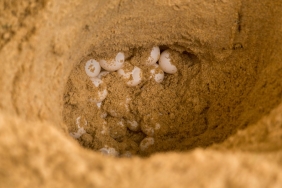LAKE BATUR FARMERS RECOGNIZE RESPONSIBLE TILAPIA FARMING PRACTICES
By Nur Ahyani
Getting to know responsible Tilapia farming was the purpose of gathering 29 Tilapia farmers representing farming groups in Lake Batur, Bali. On 18 November 2014, a Tilapia BMP socialization event took place at the Kedisan Perbekel Office, not far from the farm. Ten extension officers and the Head of Cultivation accompanied the farmers in the BMP socialization activity.
The introduction of the event was delivered by the Head of the Livestock and Fisheries Service Office of Bangli, I Made Alit Parwata. He conveyed the history of cultivation in Lake Batur which originally consisted of only six blongs, now growing to 5015 blongs. The rapid development of this cultivation is also accompanied by the emergence of various problems.
The presence of sulfur gas that appears in June-September is a natural phenomenon that forces farmers to lift their fish and take a temporary break from cultivation activities. In addition, the Fish Seed Center has also not been able to meet the need for quality seeds every year. This encourages farmers to use seeds from unclear sources, so the quality is not guaranteed.
In addition to sulfur and seed problems, farmers also still have problems with feed. So far, they have been using drowned feed from various brands without any record keeping. Feed efficiency and pollution from leftover feed are problems in cultivation. The absence of records makes it difficult to know and compare which feed is the most efficient and most profitable.
The Head of Bangli Livestock and Fisheries Service Office stated that the agency does not remain silent about these problems. The Service always gives an early alarm to the onset of sulfur gas, so that farmers are prepared to harvest their fish. To maintain the continuity of seeds, the Service also provides assistance to tilapia breeders who breed in rice fields. To improve the efficiency of feed use, the Service is trying to conduct research with a multilevel cage system, so that leftover feed can be utilized by fish reared at the lower level.
After remarks from the Head of Department, the event continued with a presentation from Wahju Subachri, Aquaculture Senior Officer of WWF-ID. Since WWF is still unfamiliar to the farmers in Lake Batur, Wahju started the presentation about what WWF is and its programs. Farmers then had the opportunity to get to know responsible Tilapia farming practices according to BMP rules through the screening of BMP videos.
After about the video screening, Wahju explained the steps of responsible Tilapia farming in more detail. Occasionally, Wahju modeled the practices carried out by farmers in Lake Toba-North Sumatra, where WWF-ID has been assisting Tilapia farmers since 2011. Wahju also said that BMPs could be one of the solutions to solve the problems expressed by the Head of Department.
In the question and answer session, the questions asked by the farmers were more technical in nature, such as how to achieve a survival rate (SR) of more than 50%. In their experience, aquaculture in Lake Batur only has a maximum SR of 50%. Many farmers also asked about feed, such as how sinking feed is better than floating feed. Not to forget, what is always a favorite question for farmers, which is the problem of disease. Farmers shared symptoms of diseases and asked for advice on treatment and prevention.
This socialization activity was closed with a statement from the Extension Coordinator, Sang Putu Dirga, that the cultivator groups in Lake Batur are ready to implement Tilapia Cultivation BMPs. Although not all of the farmers who attended showed enthusiasm, but WWF-ID can see the optimism and potential of the interest of some farmers.
The program will continue with a detailed identification of groups that really want to implement BMPs. WWF-ID will then work with the Department to provide assistance.
Everything big starts small. It is hoped that the pilot cultivation practices according to BMPs in one or two groups can spread to other groups.





